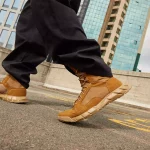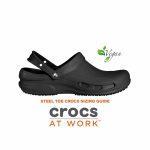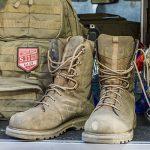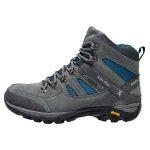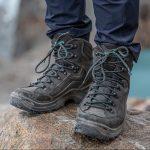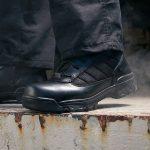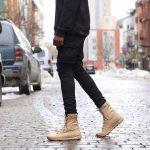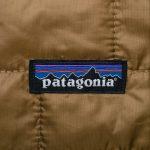Size chart for Safety Shoes and Boots
What size of safety shoe or boot suits you?
The Size Chart for safety Shoes and Boots is the answer to many questions we received at size-charts.com. You’ll discover how to find your perfect fitting safety shoe or safety boot you need to get through your working day.
Correctly sized boots should feel snug but not tight. Safety Shoes or Safety Boots should be small enough to keep your feet from moving around too much in your boots.
If your foot slides into a boot too easily, the boots are likely too large.
In this post we’ll handle the following items.
- How to measure your feet for safety shoes or safety boots?
- How to try your new safety shoes or safety boots
- The difference between safety shoes, safety boots, and work shoes or occupational shoes
- Women’s safety shoes and boots size chart
- Men’s safety shoes and boots size chart
- Unisex safety shoes and boots size chart – men to women size converter
- Safety Shoes Chart Width and effects of too narrow shoes
- Safety Shoes and boots FAQ
Measure your feet when buying safety shoes and boots online
How do i know my safety shoes size?
Don’t count on your regular shoe size when you want to buy safety shoes. Due to the shoe’s protective elements, the sizes and dimensions are slightly different from dressed or casual footwear.
Like in many posts, it all starts with measuring your feet.
To make it easy, we summed up our tips to measure your feet :
You will need: your socks, a piece of paper or cardboard, a tape measure or ruler, and a pen
Time needed: 3 minutes
10 easy steps to measure your feet correctly:
- Measure your feet in the afternoon.
Your feet swell during the day, it’s best to measure your feet at their fullest
- Stand When Measuring
When in a wheelchair there’s no pressure on the feet, so it’s unnecessary to stand up.
- Wear socks
Most of the time you wear socks in your shoes. Make sure you wear socks when you measure your feet.
- Be precise
- Measure both feet
Measure your left and right foot separately as they’re not the same length. Take the biggest measurement to determine your running shoes Size
- Stand on your piece of paper
Keeping your body weight over your foot, trace a thin line around the outside of your entire foot.
- Start drawing
When drawing the line, hold the pen perpendicular to the ground.
- Measure the length of your feet
Measure vertically down the length of your foot tracing. This is your foot length.
- Find your width fitting by drawing or with measuring tape
Measure horizontally across the widest part of your foot tracing. This is your foot width.
- Determine your safety shoes size in the conversion charts
Start from the measurement in inches or centimeters and define your size in the charts for men or women
How to find your Safety boots Size
As you will be standing, walking, working for more than 10 hours with safety shoes, a good fit is essential. Do this thoroughly as you might get injured or fatigued faster than with perfect fitting safety shoes. Follow the below steps to determine what size of safety shoes will get you through the working day.
How to try on safety shoes or safety boots?
- Completely lace-up your footwear.
- Walk around briefly in your new footwear to feel and check the comfort.
- Ensure the boot/shoe and your foot bend in the same place.
- Pay attention if you don’t feel the protective toecap in the bending zone.
- The boot/shoe arch and your foot arch should line up perfectly.
- Your heel should be feeling well supported and sufficient grip in the heel cup.
- Make sure you have enough toe space (your toes shouldn’t touch the end)
Try on your new footwear on carpet or solid flooring to ensure a good fit and keep the soles clean if you need to make an exchange.
Safety Shoes and Boots are not Working or Occupational shoes
Do not confuse Safety shoes or boots with Working shoes:
- Safety Shoes/Boots offer protection for toes and, in many cases, also with an anti-perforation plate.
Safety footwear comes mostly in 2 standards: ASTM 2413 & EN ISO 20345. - Working shoes (or occupational footwear) are designed and engineered to do your daily job with more focus and offer no toe protection. This kind of shoes comes with the ISO standard: EN ISO 20347
Many of the footwear styles in safety shoes and boots are designed to be worn by both men and women. There is a difference of roughly 1.5 – 2 sizes between men’s and women’s boots and shoes, depending on the brand.
What size of safety shoe or safety boot you need to wear you can find in below charts.
Women’s Safety Shoes and Boots Size Chart
How to measure your foot, you can find out here. You can find the correct women’s shoe or boot size using the chart below. The Size Chart contains the international standards for US & CAN, Europe, The United Kingdom, and Mexico. The size in CM is the same as the Japanese Sizes.
| FOOT LENGTH (IN.) | FOOT LENGTH (CM) | SHOE SIZE (US & CAN) | SHOE SIZE (EU) | SHOE SIZE (UK) | SHOE SIZE (MEX) |
| 8 | 20.3 | 3 | 32.5 | 2 | 20 |
| 8-1/8 | 20.6 | 3.5 | 33 | 2.5 | |
| 8-3/8 | 21 | 4 | 33.5 | 3 | 21 |
| 8-1/2 | 216 | 4.5 | 34 | 3.5 | |
| 8-5/8 | 22 | 5 | 34.5 | 4 | 22 |
| 8-7/8 | 22.5 | 5.5 | 35.5 | 4.5 | |
| 9 | 22.9 | 6 | 36.5 | 5 | 23 |
| 9-1/8 | 23.2 | 6.5 | 37 | 5.5 | |
| 9-3/8 | 23.7 | 7 | 37.5 | 6 | 24 |
| 9-1/2 | 24.1 | 7.5 | 38 | 6.5 | 25 |
| 9-5/8 | 24.5 | 8 | 38.5 | 7 | |
| 9-7/8 | 25 | 8.5 | 39 | 7.5 | 26 |
| 10 | 25.4 | 9 | 39.5 | 8 | |
| 10-1/8 | 25.7 | 9.5 | 40 | 8.5 | 27 |
| 10-3/8 | 26.3 | 10 | 41 | 9 | |
| 10-1/2 | 26.7 | 10.5 | 42 | 9.5 | 28 |
Safety Shoes and boots for women sizes explained
Men’s Safety Shoes and Boots Size Chart
How to measure your foot, you can find out here. You can find the correct Men’s shoe or boot size using the chart below. The Size Chart contains the international standards for US & CAN, Europe, The United Kingdom, and Mexico. The size in CM is the same as the Japanese Sizes.
| FOOT LENGTH (IN.) | FOOT LENGTH (CM) | SHOE SIZE (US & CAN) | SHOE SIZE (EU) | SHOE SIZE (UK) | SHOE SIZE (MEX) | MONDO POINT |
| 9-1/2 | 24.1 | 6 | 38 | 5.5 | 24.5 | 24 |
| 9-5/8 | 24.5 | 6.5 | 38.5 | 6 | 25 | 24.5 |
| 9-7/8 | 25.0 | 7 | 39 | 6.5 | 25.5 | 25 |
| 10 | 25.4 | 7.5 | 39.5 | 7 | 26 | 25.5 |
| 10-1/8 | 25.7 | 8 | 40 | 7.5 | 26.5 | 26 |
| 10-3/8 | 26.3 | 8.5 | 41 | 8 | 27 | 26.5 |
| 10-1/2 | 26.7 | 9 | 42 | 9 | 27.5 | 27 |
| 10-5/8 | 27.0 | 9.5 | 42.5 | 9.5 | 28 | 27.5 |
| 10-7/8 | 27.5 | 10 | 43 | 10 | 28.5 | 28 |
| 11 | 28.0 | 10.5 | 43 | 10 | 29 | 28.5 |
| 11-1/4 | 28.7 | 11 | 44 | 10.5 | 29.5 | 29 |
| 11-3/8 | 29.5 | 11.5 | 45 | 11 | 30 | 29.5 |
| 11-7/8 | 30.1 | 12 | 46 | 11.5 | 30.5 | 30 |
| 12-1/4 | 31.0 | 13 | 47 | 12.5 | 31.5 | 31 |
| 12-3/4 | 31.6 | 13.5 | 48 | 13 | 32 | 31.5 |
Unisex Safety Shoes and Boots Size Chart
Convert the mens’ sizes into women’s sizes. The width in Safety shoes and boots mainly remains the same, so a D remains a D width safety shoes.
| MEN’S SIZE | WOMENS’ SIZE |
| 8 | 9.5 – 10 |
| 8.5 | 10 – 10.5 |
| 9 | 10.5 – 11 |
| 9.5 | 11 – 11.5 |
| 10 | 11.5 – 12 |
| 10.5 | 12.- 12.5 |
| 11 | 12.5 -13 |
| 11.5 | 13 – 13.5 |
| 12 | 14 – 14.5 |
| 12.5 | 14.5 – 15 |
| 13 | 15 – 15.5 |
Safety Shoes and Boots Size Chart: the width
Safety Shoes and Boots‘ width is incredibly important when achieving the correct fit, as you are wearing them the whole day long.
A great rule of thumb (or toe, in this case) is that the ball of your foot should sit at the widest part of the shoe. To illustrate the importance of the correct width in your safety shoes or safety boots.
- if it’s too narrow, you can develop blisters
- it’s too narrow it will be impossible to stay a full day with them
- if it’s too narrow you can have blood circulation problems
- if you have diabetes, you can have serious circulation problems
- if it’s too wide you can twist your ankle or fall
- if it’s too wide, you are not safe, and you might slip or cause accidents
- if it’s too wide, the inside materials will break
| Shoe Size US | Shoe Size EU | Shoe Size UK | Width mm | Width mm | Width mm | Width mm | |
| W: 9 M: 7 | 39 | 6-7 | 234 240 | 241 246 | 254 258 | 266 270 | |
| W: 10 M: 8 | 40 | 7-8 | 241 246 | 247 252 | 260 264 | 272 276 | |
| W: 11 M: 9 | 41-42 | 8 | 247 252 | 254 258 | 266 270 | 278 282 | |
| W: 12 M: 10 | 42-43 | 8-9 | 254 258 | 260 264 | 272 276 | 284 288 | |
| TRADITIONAL US NAME ABBREVIATED | D FIT Standard MEDIUM (M) | E FIT Wide WIDE (W) | EEE FIT Extra Wide (WW, XW, 2W) | EEEEE FIT Ultra Wide (XXW, 4W) |
Skechers Works has some great WIDE FIT SAFETY SHOES AND BOOTS : check the size charts here.
Different Safety Shoes or Safety boots width indications are:
- A = Extra Narrow
- B = Narrow
- D / M = Medium or Standard
- E / EE / W = Wide
- EEE / EW / WW = Extra Wide
- 4E / EEEE = Extra Extra Wide (or Ultra Wide)
Safety shoe sizing explained
Why is my Safety boot size different than my shoe size?
Depending on the boot, you may more often go down 1/2 size because they are made to wear thick socks in and they are more high volume than shoes. What this means is there is more volume or space inside the boot to account for the need to wear thick socks.
Related work size charts
- Oakley Boots Size Charts: Men, Women
- Danner Boots Size for Men and Women
- Steel Toe Crocs Size Guide for women and men
- 5.11 Boots Size Charts for Men and Women
- Under Armour Tactical Boots Size Chart
- Men’s Workwear Size Chart
- McKinley Shoes Size
- LOWA Boots Sizes for Adults and Kids
- What is my Bates Boots Size?
- What’s My Nike Tactical Boot Size?
- What Is My Dickies Workwear Size? (Charts Included)
- Nursing Uniform Size for Men & Women: How do I know my size?
- Patagonia Workwear Size Guide

